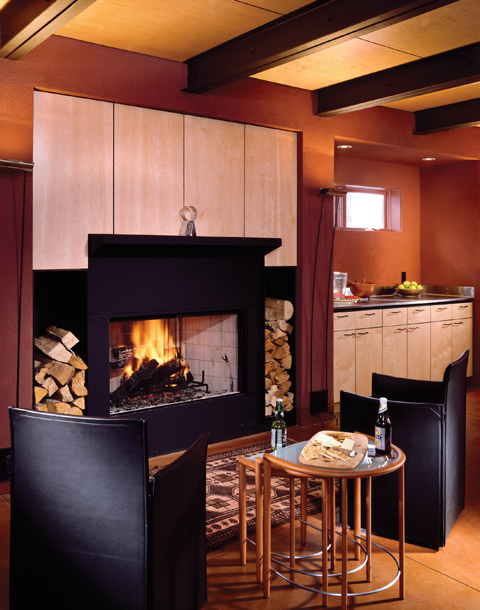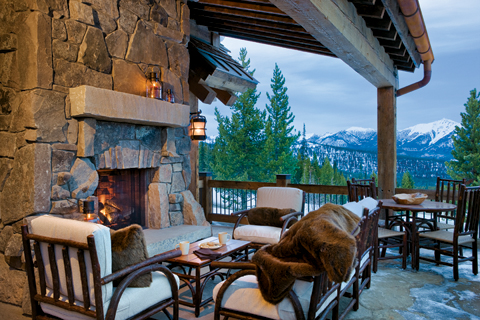Fire has descended through the ages of mankind from a necessity for survival to a luxury of comfort and ambience. The earliest shelters were equipped with wood-burning pits, fireplaces, or stoves for cooking and heating. While fireplaces may still serve those primary functions in some households, the majority are designed and installed for pure enjoyment, with an added benefit as a secondary heat source for the home.
Architect Greg Dennee, a partner at Bozeman-based Locati Architects, says, “It’s safe to say that each of our clients comes to us with an expectation for at least one fireplace in their house. With much of our work in northern and alpine climates, the fireplace is a comforting addition and quite often the centerpiece of gathering areas in the home.” Dennee says that nearly every client desires a fireplace in the living room or great room and, quite frequently, in the master bedroom. “What has been fun lately,” sites Dennee, “is a trend toward fireplaces in kitchens, cozy hearth/nook spaces, and outdoor living areas. The outdoor fireplace significantly transforms the usability of those outside living spaces, extending the amount of time and seasons that families can spend there.”
Fireplaces can be wood or gas burning. They can feature full masonry chimneys or wood-framed chases with metal flues. A wood-burning fireplace may include a gas lighter, which aids in getting a fire started. Fireplace options are many and varied, so choices should be made after careful consideration and research of products, as well as an honest evaluation of what type of fireplace best suits your family’s lifestyle.
“Most of our clients prefer the ambience and authenticity that comes with a true wood-burning fireplace,” says Dennee. “The added sensory experience of the sounds and smell of burning wood is a significant part of the enjoyment. Certainly gas log sets or gas fireplaces add an element of convenience, and often they are good solutions in bedrooms, offices, or other areas where the level of control and timing of usage are more sensitive.” Dennee explains that there have been great advancements in the technology of gas units in both aesthetics and efficiency, so they can be an attractive option. “And,” he adds, “in some areas of the country, wood burning is limited or even restricted, by ordinance or other local covenants, and a gas alternative may be required.”

Stephen Dynia Architects/photo by Roger Wade
Fireplaces are increasingly being rendered in materials other than stone or brick. Dennee says, “Fireplace surrounds crafted in decorative concrete, tile, wood, and metal are popular and can often help a rather traditional fireplace fit with a more contemporary design.” He shares that, in terms of the firebox itself, some interesting new shapes have been developed, including long “linear” style burners and wood-burning corner or two-sided fireplaces, both of which create exciting design opportunities.
Dennee deems that most of Locati Architect’s homeowners use fireplaces as a secondary source of heat, with the primary benefit being the enjoyment of the fire and the addition of character to the space it adjoins. “That said,” he maintains, “it’s very important to consider the added heat that can be generated from a fireplace, especially with today’s highly insulated and airtight construction methods.”
For homeowners who want to stick to a budget when building a new house, there are some fireplace cost-saving tips to consider. “The bulk of the cost of a fireplace often has to do with the stone or brick used as a surround,” Dennee points out. “We always advocate using the best quality, safest fireplace product available, but perhaps consider using a less expensive surround in support of it. Some of the most interesting fireplace designs are quite simple in design, keeping the emphasis on the fire itself.” Pre-engineered fireplaces are also a viable budget-friendly option to consider. They are far easier (and far cheaper!) to install than a full masonry fireplace. Some are made with lightweight brick, others are cast concrete. They function just like a masonry fireplace, and as such can also be equipped with a gas lighter, or gas logs.

Ruth Black
Dennee maintains that, without question, safety is the highest priority for successful fireplace design and construction. Using reputable masons for fireplace installation is paramount, and insisting that the fireplace be built to meet all local codes and installed to the manufacturer’s requirements is equally important. “Also important,” says Dennee, “is simply using the fireplace responsibly; keeping an eye on it while burning, positioning flammable furniture and objects at a safe distance, and extinguishing the fire completely when finished.”
Installing a fireplace in an existing home is considerably more difficult and costly than incorporating one into new construction. “That said,” counsels Dennee, “there are some amazing inserts available, as well as ‘modular’ masonry kits that allow fireplaces to be constructed without the same level of structural support as one might expect in a masonry fireplace.” Gas fireplaces are also a good option for remodels because they require minor modifications to the existing room they will occupy. They do, however, need to be vented. In a remodel situation, designers and contractors should always be aware of the potential need to bring in additional air to support a healthy, drawing fireplace.
With the wide selection of fireplace options available today, it makes sense, as with any major purchase, to take the time to explore the marketplace. As Greg Dennee suggests, a fireplace can serve as the focal point of a room, even an entire home. There is abundant information on the Internet with regard to various types of fireplaces and radiant heat stoves. Interface with professionals who can offer you reliable information on the pros and cons of different styles and models. Select the type that resonates with your lifestyle and design sense. A fireplace is not something you are likely to replace in the life span of a home, but rather the core of it; a vortex that evokes a sense of comfort and general well being. And, with wood, there’s that extra bonus of snap, crackle, and pop!

